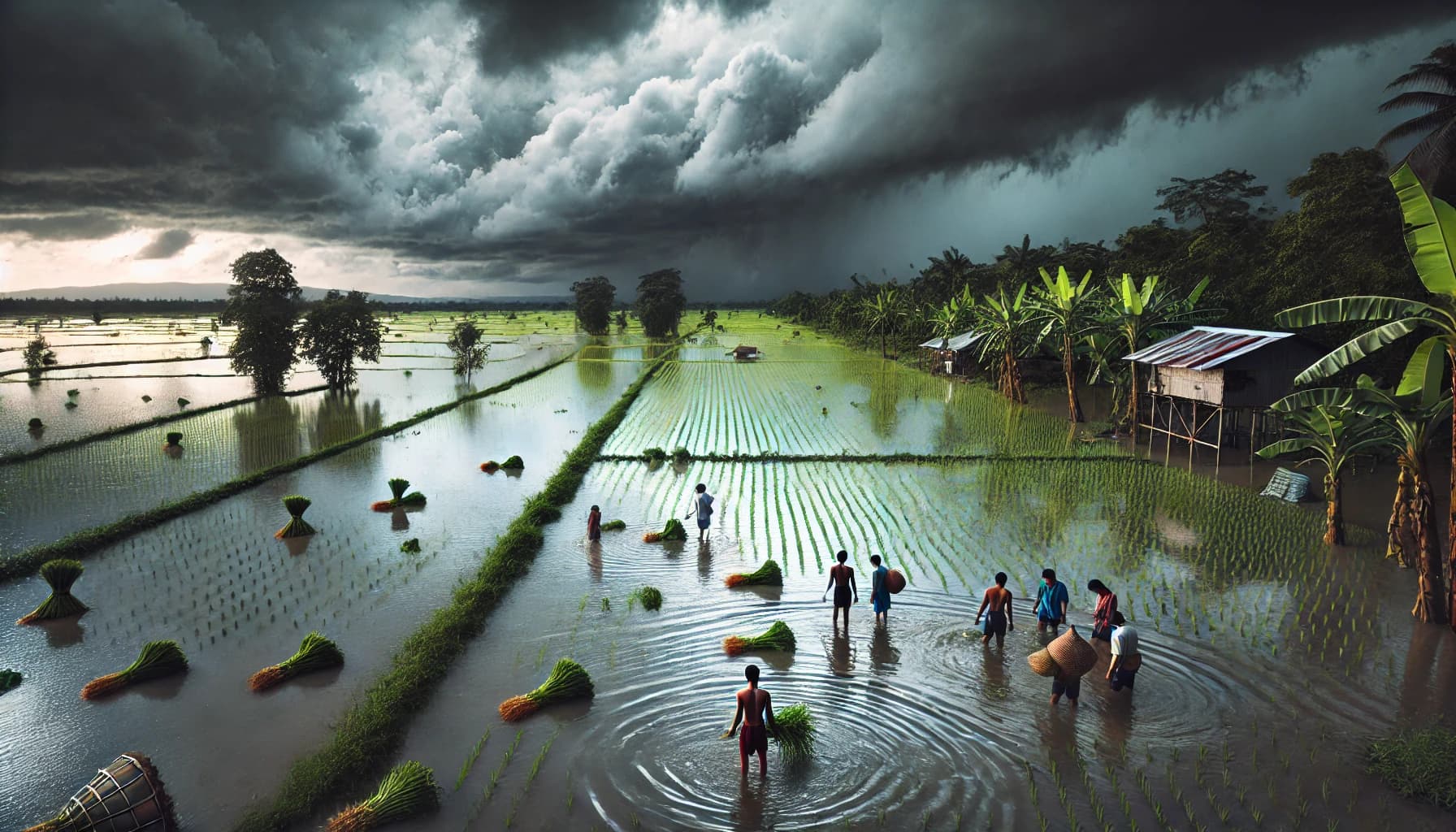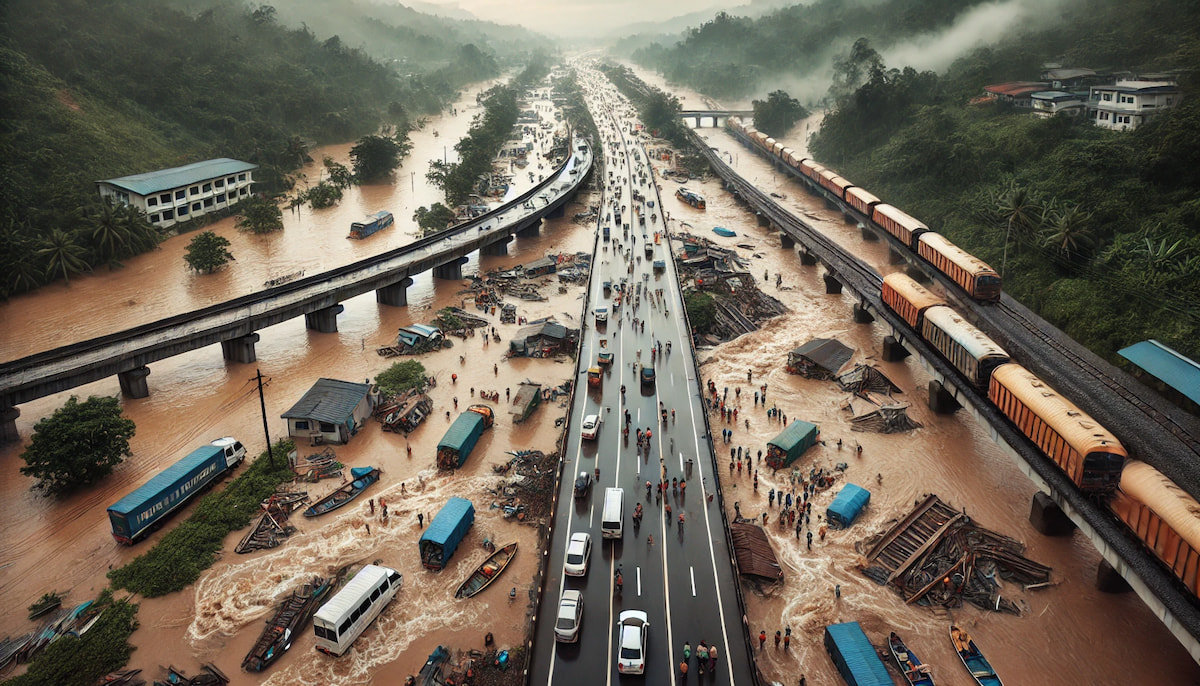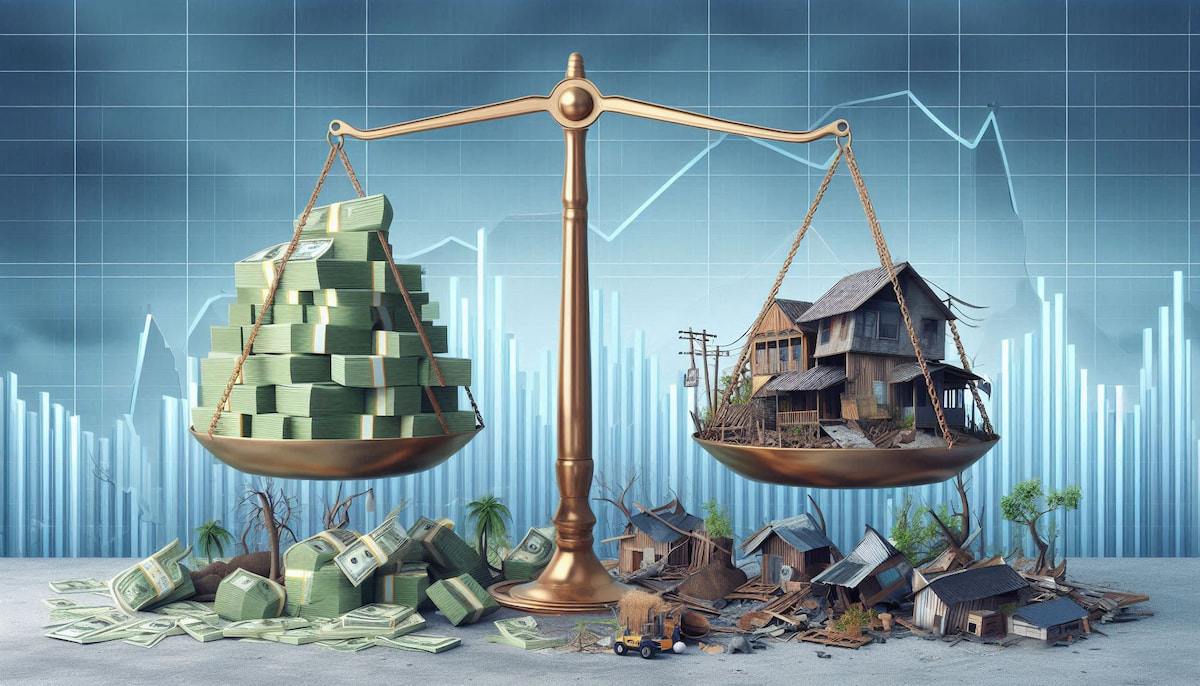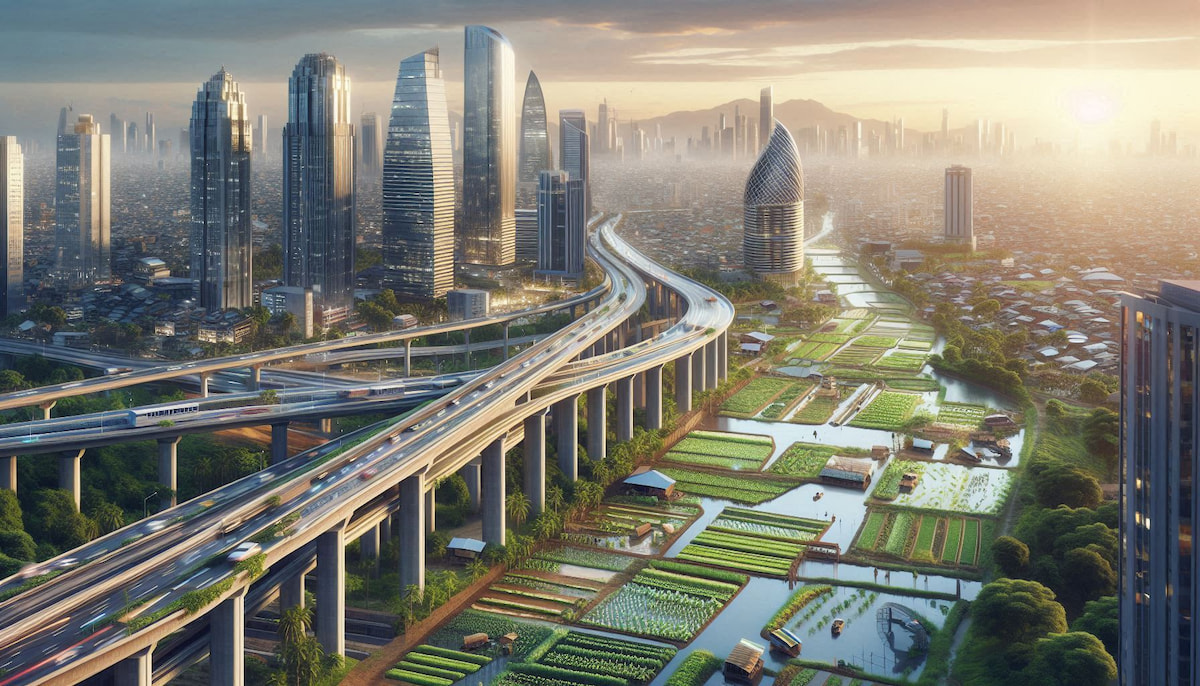
Watch short for this article (5 slides)
Southeast Asia's Economy Under Siege: The Compounding Impact of Tropical Storms
Southeast Asia, a region known for its vibrant cultures, dynamic economies, and stunning natural beauty, lies in one of the world's most active basins for tropical cyclones (known locally as typhoons). While these powerful storms are a recurring natural hazard, their increasing frequency and intensity, widely linked to climate change, pose a severe and compounding threat. The simultaneous or sequential occurrence of multiple storms can cripple economies, devastate livelihoods, and strain recovery efforts across nations heavily reliant on climate-sensitive sectors. Understanding the deep economic scars left by these events is crucial for building resilience in this vulnerable region.

Multiple simultaneous tropical cyclones place immense strain on Southeast Asia's economies and infrastructure.
Understanding the Heightened Threat in Southeast Asia
Several factors make Southeast Asia particularly susceptible to the destructive power of tropical cyclones:
- Geography: Situated around the warm waters of the Western Pacific Ocean, the region experiences the highest global frequency of tropical cyclone formation. Archipelagic nations like the Philippines and Indonesia, along with countries boasting long coastlines like Vietnam and Thailand, are directly exposed.
- Climate Change Multiplier: Scientific consensus, including reports from the Intergovernmental Panel on Climate Change (IPCC), indicates that climate change is exacerbating the threat. Warmer sea surface temperatures provide more energy to fuel stronger storms. A warmer atmosphere holds more moisture (approximately 7% more per degree Celsius), leading to heavier rainfall and increased flood risk. Additionally, sea-level rise significantly worsens the impact of coastal storm surges. (Source: IPCC AR6 WG1 Report)
- Socio-Economic Factors: High population densities in coastal areas, significant reliance on agriculture and fisheries, developing infrastructure in many areas, and dependence on tourism increase the region's vulnerability to storm impacts.
- Nature of Cyclone Damage: Tropical cyclones inflict damage through multiple mechanisms:
- Extreme Winds: Causing structural damage to buildings, infrastructure (power lines, communication towers), and vegetation.
- Torrential Rainfall: Leading to widespread inland flooding, flash floods, river overflows, and potentially devastating landslides in mountainous areas.
- Storm Surge: An abnormal rise in sea level pushed ashore by the storm's winds and low pressure, causing catastrophic coastal inundation, erosion, and saltwater intrusion into freshwater sources and farmland.
Sector-by-Sector: The Economic Devastation
The economic impacts of severe tropical storms ripple through virtually every sector in Southeast Asia.
Agriculture: Foundation Under Threat
Often the backbone of rural economies, agriculture suffers immediate and severe losses:
- Crop Destruction: High winds can snap stems (banana, papaya), strip fruit, and cause lodging (flattening) in crops like corn and sugarcane. Widespread flooding submerges rice paddies, leading to root rot and crop failure – devastating for a staple food source. Coastal storm surges cause saltwater intrusion, rendering fertile farmland unusable for years. Aquaculture ponds are destroyed or contaminated.
- Livestock Losses: Animals drown in floods, perish from exposure or lack of feed, or succumb to diseases spread by contaminated water post-storm. Shelters and feed stores are often destroyed.
- Fisheries Disruption: Fishing fleets are damaged or destroyed. Storm surge and runoff can damage vital coastal habitats like mangroves and coral reefs, which serve as nurseries for commercial fish stocks. Fishing activities are halted for extended periods during and after storms.
- Example - Philippines: Agriculture constitutes a significant portion of GDP and employment. Typhoons frequently cause billions of pesos in agricultural damage, impacting food security and farmer livelihoods.
Infrastructure and Transportation: Severed Lifelines

Damaged infrastructure, like flooded roads and downed power lines, cripples transportation and economic activity.
Damage to infrastructure paralyzes economic activity and requires enormous recovery investment:
- Transportation Networks Crippled: Landslides and floodwaters wash out roads and destroy bridges, isolating communities and halting the movement of goods and people. Ports suffer damage from storm surge and high winds, delaying shipping and international trade. Airports close due to wind, flooding, or damage, disrupting travel and air cargo.
- Utility Failures: Downed power lines lead to widespread electricity outages, halting businesses, disrupting communication, and impacting essential services like hospitals and water treatment plants. Water supply systems can be damaged or contaminated by floodwaters. Communication networks (cell towers, fiber optic lines) are often disrupted.
- Massive Repair Costs: Governments face immense, often unbudgeted, costs for repairing and rebuilding damaged roads, bridges, ports, power grids, and public buildings, diverting funds from other development priorities.
Tourism: A Vulnerable Economic Engine
Many Southeast Asian economies rely heavily on tourism, particularly in scenic coastal areas directly in the path of cyclones:
- Direct Damage and Closures: Hotels, resorts, and tourist attractions suffer structural damage from wind and storm surge. Beaches erode. Natural attractions like coral reefs or forests may be damaged.
- Operational Disruptions: Flight cancellations strand tourists and halt arrivals. Damaged infrastructure prevents access. Safety concerns lead to temporary closures.
- Long-Term Reputational Risk: Frequent or particularly devastating storms can create a perception of risk, deterring international tourists long after the immediate recovery, impacting bookings and investment in the sector. Coastal communities dependent on tourism face severe economic hardship.
Industry and Commerce: Widespread Business Interruption
- Production Halts: Manufacturing facilities and businesses shut down due to direct damage, power outages, disrupted supply chains (raw materials in, finished goods out), and workforce unavailability.
- Supply Chain Chaos: Damage to ports, roads, and warehouses creates bottlenecks, affecting both domestic and international trade.
- Small Business Impacts: Small and Medium Enterprises (SMEs), often lacking robust insurance or contingency funds, are particularly vulnerable and may struggle to recover, leading to job losses and community decline.
The Compounding Cost: Beyond Individual Events

Economic losses from storms are substantial and often compound when multiple events occur.
While single major storms incur massive costs (e.g., Typhoon Haiyan/Yolanda in 2013 caused an estimated $14 billion USD in damages in the Philippines), the economic strain is amplified when storms occur frequently or in quick succession, as seen sometimes during active typhoon seasons.
- Depleted Resources: Recovery efforts from one storm deplete emergency funds, relief supplies, and personnel capacity, leaving regions more vulnerable when the next storm hits.
- Hindered Recovery: Damage to infrastructure from one event slows down the rebuilding process, making subsequent impacts more severe.
- Cumulative Stress: Repeated disruptions erode business confidence, hinder long-term investment, and trap communities in cycles of damage and recovery, impeding sustainable development.
- Indirect Costs: Official damage figures often underestimate the true economic toll, failing to capture long-term impacts like reduced productivity, health costs (waterborne diseases, mental health impacts), lost educational opportunities, and environmental degradation.
Building Back Better: Strategies for Economic Resilience
Recognizing the escalating threat, governments, international organizations (like the World Bank and Asian Development Bank - ADB), and the private sector are increasingly focusing on building resilience:

Investing in disaster-resilient infrastructure and early warning systems is key to mitigation.
- Disaster-Resilient Infrastructure: Investing in building codes and construction techniques that withstand higher wind speeds and flooding. Elevating critical infrastructure (power stations, hospitals). Reinforcing coastal defenses using both hard structures (sea walls, breakwaters) and nature-based solutions (mangrove restoration/protection, coral reef conservation). (Source: Asian Development Bank - DRM)
- Advanced Early Warning Systems: Strengthening national meteorological agencies (like PAGASA in the Philippines, VNHMS in Vietnam) to provide accurate, timely forecasts and impact-based warnings. Disseminating warnings effectively to vulnerable communities.
- Integrated Water Resource Management: Improving flood control infrastructure (dams, levees, diversion channels, urban drainage), coupled with better watershed management and land-use planning to reduce runoff and flood risk.
- Financial Protection Mechanisms: Developing national disaster funds, promoting climate risk insurance schemes (including parametric insurance triggered by specific storm parameters), and accessing international climate finance.
- Agricultural Adaptation: Promoting climate-resilient practices like planting flood-tolerant or salt-resistant crop varieties, improving irrigation and drainage, diversifying crops, and providing weather-indexed insurance for farmers.
- Ecosystem-Based Adaptation: Recognizing the protective role of healthy ecosystems – mangroves, coral reefs, and forests – and investing in their conservation and restoration as natural buffers against storm impacts.
- Long-Term Economic Diversification: Strategically shifting economies away from heavy reliance on the most climate-vulnerable sectors towards more resilient industries like technology, manufacturing, and services, thereby reducing the overall economic exposure to storm disruptions.
Conclusion: Facing the Winds of Change
Tropical cyclones pose a formidable and growing economic challenge to Southeast Asia. The compounding impacts of intense and frequent storms, amplified by climate change, threaten decades of development gains and jeopardize the livelihoods of millions. Simply rebuilding after each disaster is unsustainable. Building long-term economic resilience requires a proactive, integrated strategy encompassing infrastructure hardening, sophisticated early warning systems, innovative financial tools, nature-based solutions, agricultural adaptation, and strategic economic diversification. Continued investment, robust policy implementation, and international cooperation are essential if the region is to successfully navigate the increasing fury of the storms and secure a sustainable and prosperous future.